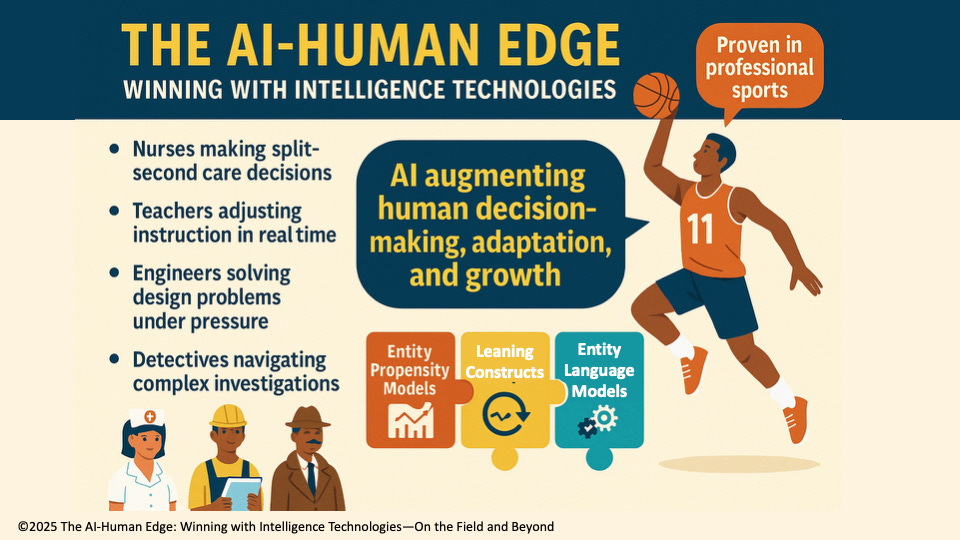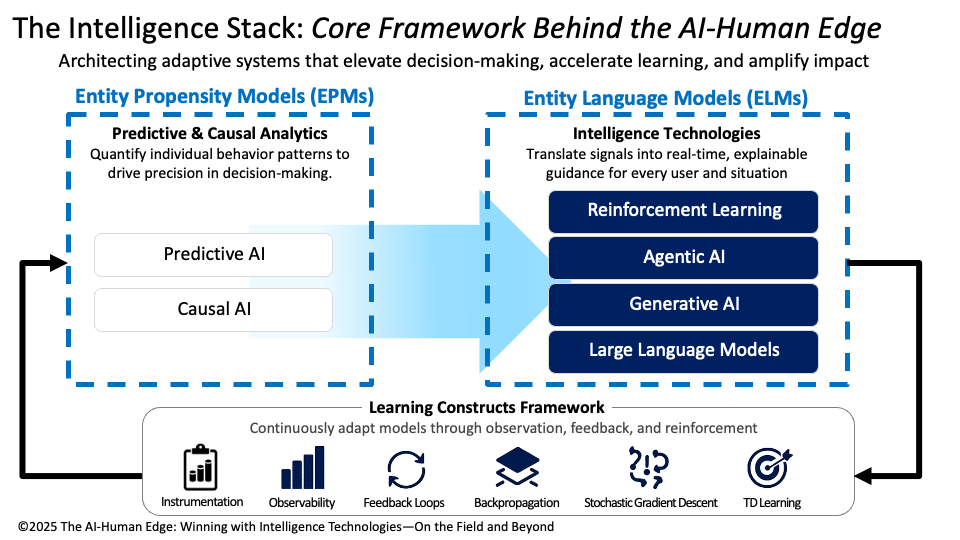Introducing The AI-Human Edge: A Playbook for Augmenting Human Potential – Part 1
I’m working on a new book titled “The AI-Human Edge: Winning with Intelligence Technologies – On the Field and Beyond.” The book primarily focuses on professional and college sports as the testing ground for AI-driven human performance enhancement—an environment where human performance, outcomes, and value are readily observable. In sports, we can understand who is most valuable, see who improves, and how they perform under various situations. This clear feedback and consequence make it the perfect environment for testing how AI can enhance human decision-making, adaptation, and growth.
But here’s the twist: the real goal of the book isn’t about sports.
It’s about showing how the same concepts that optimize athletes—Entity Propensity Models, Entity Language Models, and Learning Loops—can be used to empower all elite professionals, such as:
Nurses making split-second care decisions,
Teachers who are adjusting instruction in real time,
Engineers solving design problems under pressure,
Detectives who are navigating complex investigations.
Sports is simply the lens—what this book offers is a framework for enhancing human performance anywhere outcomes matter.
In all these roles, the opportunity to augment human potential with intelligence technologies is unprecedented.
The AI Challenge
Imagine a nurse asking an AI assistant whether it’s safe to discharge a patient. The assistant replies with a generic risk score, but without explanation, context, or room for trust.
That’s the real AI challenge: when decisions matter most, today’s tools don’t provide the level of detail and supporting rationale to drive trusted and relevant guidance.
Generative AI tools are falling short of delivering guidance that feels clear, trustworthy, or relevant to real-world demands. A chatbot might offer contradictory advice. An AI tutor may respond with technical but unhelpful answers. For professionals working under pressure—whether at the hospital bedside, in the classroom, on the playing field, or at a crime scene—this kind of randomness is a barrier to impact.
The AI-Human Edge offers a distinct approach—one built around clarity, context, and collaboration between humans and intelligent systems, grounded in an understanding and quantification of the causal factors that drive stakeholders’ and constituents’ behaviors and performance.
A More Adaptive AI Stack
Rather than relying on a single technology to do everything, the book embraces a more adaptive architecture—one that combines core AI building blocks into flexible, human-centered systems.
It integrates Predictive AI (which forecasts future outcomes based on historical trends, patterns, and relationships) and Causal AI (which quantifies the cause-and-effect dynamics behind those trends and outcomes) with what we call Intelligence Technologies:
Generative AI: Creates new content, scenarios, and options—from tactical play diagrams to training simulations—by synthesizing patterns from existing knowledge.
Agentic AI: Functions as an autonomous assistant that can perceive, decide, and act within a defined environment, continuously learning and adapting to user needs.
Language Models: Enable natural-language understanding and communication, supporting human-like dialogue and real-time contextual guidance. These are the foundation of Entity Language Models (ELMs).
Reinforcement Learning: Powers systems that learn from actions and outcomes over time, refining their strategies through trial, error, and feedback—much like a coach helping an athlete improve rep by rep.
These tools understand goals, adapt to context, act as teammates, and explain their reasoning to ensure transparency and confidence.
At the core of this architecture are three essential analytic concepts (Figure 1):
Entity Propensity Models (EPMs): These causally grounded behavioral models utilize Predictive and Causal AI to estimate what is likely to happen and why. EPMs create a transparent, personalized baseline tailored to each individual’s tendencies, helping systems ground their decisions in reality.
Entity Language Models (ELMs): ELMs utilize Intelligence Technologies to translate those insights into natural language guidance that feels personal and contextual, making recommendations more trusted, relevant, and accurate over time.
Learning Constructs: These are the digital equivalent of muscle memory. Encompassing mechanisms such as instrumentation, feedback loops, observability, stochastic gradient descent, backpropagation, and Temporal Difference learning, they enable systems to learn continuously, much like athletes reviewing film or teams iterating on their tactics.
Figure 1: The EPM-ELM Intelligence Stack
This blended approach solves many of the problems plaguing today’s AI tools:
Causally driven predictions that clarify why an outcome is likely
Contextually aware language that matches how humans listen, evaluate, and decide
Transparent, feedback-rich loops that improve the system over time
The EPM–ELM framework, combined with the Thinking Like a Data Scientist methodology, unlocks your organization’s tribal knowledge to create AI-guided recommendations that augment human intelligence by sensing, learning, and adapting.
Why Sports Is the Ultimate Sandbox
If you wanted to design the perfect environment for testing intelligence systems, you’d end up with something that looks a lot like sports. Because sports deliver something most industries struggle to provide: objective, observable outcomes. Did the shot go in? Was the play successful? Did the team win? These outcomes are crystal clear—and they’re accompanied by rich contextual metadata: who was on the field, what the play call was, how much time was left, and how fatigued the players were.
In addition to measurable outcomes, sports have natural feedback loops built in. In-game coaching adjustments, film reviews, scouting breakdowns, strength and conditioning adjustments, and tactical debriefs are all part of the regular feedback. That makes it easier to capture, compare, and improve decisions over time—exactly what intelligent systems are designed to do.
Most importantly, sports normalize experimentation and iteration. Coaches try new lineups. Players adjust their mechanics. Analysts adapt their game plans based on their opponent's behavior. It’s a culture that already expects constant learning.
So, while this book is about much more than sports, sports give us the clearest and cleanest view into how intelligence technologies, such as EPMs, ELMs, and feedback-driven models, actually work. It’s the sandbox where we can prove what’s possible, then carry those lessons to nurses, teachers, engineers, and every high-impact human who depends on rapid, trusted decision support.
Conclusion: From the Field to the Frontline
The real purpose of The AI-Human Edge isn’t to teach AI through sports. It’s to teach how AI can elevate human potential—in sports, yes, but far beyond it.
What sports offer is a proving ground. What the book provides is a blueprint: a way to create systems that learn, adapt, and guide in real time, designed not to replace human judgment but to enhance, augment, and unleash it.
If we can use AI to help a baseball manager decide when to pull the pitcher, we can use it to help a nurse prioritize care, a teacher adjust instruction, or a technician troubleshoot a complex machine. The underlying principles are the same: observe, model, learn, and adapt.
Part 2 will unpack those principles in more detail, laying out the Intelligence Stack that powers the AI-Human Edge and exploring how it turns raw data into trusted, situation-aware guidance.
This isn’t a story about AI technology. It’s a story about augmenting human talent. It’s about learning faster, adapting smarter, and winning together.
🙏🏼 Special Thanks to Essential Book Contributors
Renee Lahti read this book cover to cover to ensure it was clear and approachable. If the explanations make sense, you have Renee to thank. Wei Lin, the most impressive data scientist I’ve ever met, validated the technical concepts. And Causal AI experts Mark Stouse and John Thompson contributed insights on why causal AI is the secret sauce for making Intelligence Technologies more accurate and relevant. I have learned a ton from these brilliant individuals!


